
Why Do Penguins Waddle?
Penguins are among the most fascinating and beloved creatures on the planet, often captivating our imaginations with their unique behaviors and adaptations. One of the most distinctive and charming characteristics of penguins is their waddling gait. Watching a penguin waddle is a source of both amusement and curiosity. But have you ever wondered why penguins waddle in the first place? This article delves into the reasons behind this peculiar mode of locomotion, exploring the evolutionary, anatomical, and environmental factors that contribute to the iconic penguin waddle.
Anatomical Adaptations
1. Body Structure
Penguins have a unique body structure that significantly influences their mode of movement. Their bodies are designed for an aquatic lifestyle, optimized for swimming rather than walking. Penguins have a torpedo-shaped body which reduces drag while swimming but makes walking on land a challenge. Their legs are set far back on their bodies, which helps in swimming but creates an imbalance when they walk. This anatomical arrangement necessitates a waddling movement to maintain balance.
2. Short Legs
Another contributing factor to the penguin's waddle is their short legs. Penguins have relatively short legs compared to their body size, which limits their stride length. As a result, they cannot take long steps like other birds or animals, and the short stride necessitates a side-to-side waddling motion to propel themselves forward.
3. Webbed Feet
Penguins are equipped with webbed feet, which are excellent for swimming but less suited for walking on land. The webbing aids in propulsion through water, but on land, it provides less grip and stability. This further influences the side-to-side waddling movement as they navigate their terrestrial environment.
Energy Efficiency
While waddling might seem inefficient at first glance, studies have shown that it is actually an energy-efficient way for penguins to move on land. Research conducted on Emperor Penguins revealed that their waddling gait allows them to conserve energy. The side-to-side motion helps store and release energy with each step, similar to a pendulum. This energy conservation is crucial for penguins, especially during long treks across the ice to reach breeding colonies or food sources.
Environmental Factors
1. Icy Terrain
Penguins primarily inhabit icy and snowy environments, such as Antarctica and sub-Antarctic islands. The icy terrain poses a challenge for movement, and waddling helps penguins maintain balance on slippery surfaces. By keeping their center of mass over their feet, they reduce the risk of slipping and falling on the ice.
2. Evolutionary Adaptation
The penguin's waddling gait is also an evolutionary adaptation to their environment. Over millions of years, penguins have evolved to thrive in harsh, cold climates where efficient locomotion is essential for survival. Their waddling walk is an adaptation that enables them to navigate their environment while conserving energy and reducing the risk of injury.
Conclusion
The penguin waddle is a fascinating example of how animals adapt to their environments and physical constraints. While it may appear awkward to human eyes, the waddling gait of penguins is a remarkable adaptation that allows these birds to maintain balance, conserve energy, and thrive in some of the planet's harshest environments. Understanding the reasons behind the penguin's waddle not only enhances our appreciation for these charming birds but also provides insight into the intricate ways in which nature shapes the behavior and physiology of its creatures.
